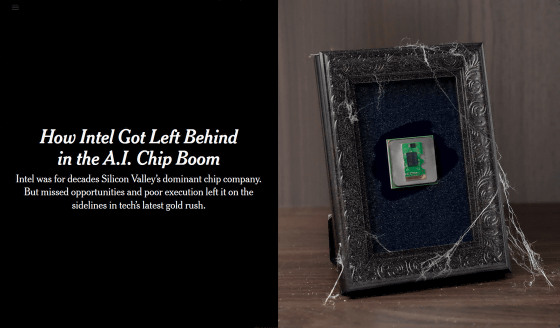Intel considered buying NVIDIA for 'just $20 billion' in 2005

By
NVIDIA is a major semiconductor manufacturer that specializes mainly in GPUs and has grown rapidly with the expansion of the AI market. At the time of writing, NVIDIA's market capitalization was $3.44 trillion (approximately 520 trillion yen), but Intel was considering acquiring NVIDIA for just $20 billion (approximately 2.2 trillion yen at the time) in 2005, according to the New York Times, a daily newspaper.
How Intel Got Left Behind in the AI Chip Boom - The New York Times
https://www.nytimes.com/2024/10/24/technology/intel-ai-chips-mistakes.html

Intel's former CEO reportedly wanted to buy Nvidia for $20 billion in 2005 — Nvidia is worth over $3 trillion today | Tom's Hardware
https://www.tomshardware.com/tech-industry/intels-former-ceo-reportedly-wanted-to-buy-nvidia-for-usd20-billion-in-2005-nvidia-is-worth-over-usd3-trillion-today
In 2005, there were no signs of an AI boom, and NVIDIA was known only as a manufacturer of GPUs specializing in computer graphics. However, even though NVIDIA GPUs were mainly used in machines for gamers, there was also a movement to apply GPUs to some computational fields that required highly parallel processing, such as oil and gas discovery.
So then-Intel CEO Paul Otellini submitted a proposal to the board to acquire NVIDIA for $20 billion. Some Intel executives, including Otellini, believed that the underlying design of GPUs would play an important role in data centers and ultimately become the approach that dominates AI systems.
But the board resisted the plan, according to two people familiar with the board discussions. Intel had little track record of acquiring companies at the time, and the $20 billion price tag would have made it Intel's most expensive acquisition yet. In the end, Otellini backed down on the deal in the face of board resistance, but one person who attended the meeting told The New York Times that it was a 'fateful moment.'
After all, at the time of writing, NVIDIA is the overwhelming king in the field of AI semiconductors, with a market capitalization of over $3.4 trillion. Meanwhile, Intel's market capitalization is below $100 billion (about 15.19 trillion yen), and some tech companies and investors are even considering the possibility that Intel could be a potential acquisition target.

The New York Times said, 'Interviews with more than 20 former Intel managers, directors and industry analysts reveal that Intel missed opportunities, made bad decisions and executed poorly.'
Intel has been working on projects to become a leader in AI chips many times, but many of the projects stopped midway because leadership lost patience or lacked technology. Investments have been prioritized in the manufacture of chips with the x86 architecture, which is the pillar of revenue, and investment in new chips has been postponed. Intel's leaders were aware of the problem of investment being concentrated in x86 chips and investment in other cutting-edge technologies being postponed, but the high profit margins made the change in policy difficult.
After plans to acquire NVIDIA fell through, Intel launched a project codenamed '
Gelsinger, who later returned to Intel as CEO, said he believed Larrabee was on the right track even after he left Intel. In an interview with The New York Times, Gelsinger said, 'I believed in Larrabee. I think the world would be very different if Intel had continued with the project, but you can't repeat history.'
In 2016, Intel acquired Nervana Systems, an emerging AI company, and developed AI products under Naveen Rao, who was the company's CEO. One of the chips developed under Rao was even used by Facebook, but in 2019, Intel acquired another AI company called Habana Labs, despite Rao's objections, and Rao left Intel. 'Intel had a ready-to-use product, but they ruined it and bought Habana Labs for $2 billion (about 220 billion yen at the time) and were two years late,' Rao told the New York Times.

The New York Times points out that in recent years, Intel has achieved some success, such as announcing the Core Ultra 200V series , a notebook processor equipped with an NPU, but these new chips are manufactured in TSMC factories, not in Intel's own factories. This is due to Intel's manufacturing technology, and that outsourcing manufacturing will reduce Intel's profits.
'NVIDIA is way ahead in the AI race. Given Intel's other challenges, I don't think they'll be able to win anytime soon,' Gelsinger said at a Deutsche Bank conference in August.
Related Posts:
in Note, Posted by log1h_ik







